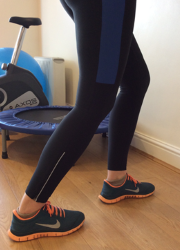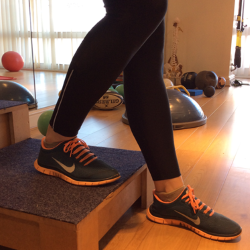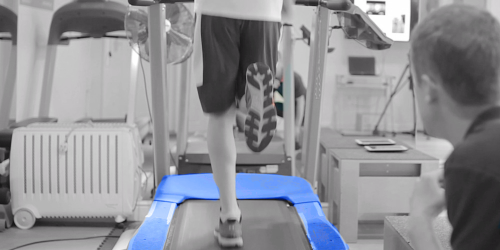Ok so clearly we are not suggesting that having good stability around your core and pelvis is not important, but what this series of three blog posts will show you is why the ability to move through your ankle is another key consideration in fixing and preventing pain and injury.
Dorsi-flexion – I’ve heard of that!
In the same way that many of our clients will have heard of pronation and supination (the rolling movement of the foot), dorsi-flexion of the ankle is another term you may have heard of. What it means is the ability of the ankle to bend as is necessary when you come down a flight of stairs. It is often described as the movement of the knee over the toe as seen in the image below.

Image 1
We will talk about how to assess this and how much movement your should have next week.
Why is this important for movement?
When we are trying to walk down stairs, run or crouch down to tie our children’s shoelaces, it is essential for the ankle to move. If anyone has tried skiing, then you will know how difficult it is to walk in ski boots and the reason is that they stop most of your ankle movement.
If your ankle movement is limited, then the problem comes not necessarily in the stress that you put on your ankle, but the fact that the brain is pretty clever and it will find a way for you to achieve the tasks that have been mentioned above. This could be through moving the knee inside of the ankle, bending more at the hip or bending more at the back. Whichever combination of those you use one thing is for sure and that is that moving in this way will place additional stress on the body.
What limits movement?
This is interesting, as most people will wrongly assume that this is a tightness of your main calf muscle the Gastrocnemius. However there are two other common potential causes, which are; the other calf muscle – Soleus and stiffness in the ankle joint itself.
The key question you have to ask yourself is; when you squat down or do the calf stretch in image 2 (below), do you feel the stretch/tension in the front or back of the ankle? If it is the front then it’s likely you have a stiff ankle and if you feel it in the back then its more likely you have tightness in Soleus.

Image 2
*Please note that pain in this position is different and should be checked by a physio or medical practitioner.
Can a limitation cause injuries?
As touched on above the simple answer here is absolutely yes. Studies show that people with limited ankle dorsiflexion suffer from more knee injuries, foot and ankle injuries and just more injuries in general. There are the obvious direct links such as Achilles Tendinopathy, where the restriction causes increased torsion on the tendon. To the less obvious such as a hamstring muscle tear, back pain and runners knee (ITB Friction Syndrome). All of these injuries are caused by the change in movement pattern that is the effect of having a stiff ankle.
Take home messages
If you have liked the information above, but are thinking what do I really need to know? Then below are the three key messages we would like to take away until the next blog post on assessment next week.
1. Dorsi-flexion is the bending motion of the ankle, that occurs in walking, stair climbing and running
2. A limitation in the ankle will be compensated for within the body by the arch of the foot rolling in, the knee collapsing in or the knee, hip and back bending more
3. This compensation can be an underling cause of many of the overuse injuries that we see in clinic every week.
If you think that you have stiffness in this area that is causing or has caused a problem then please e-mail us at E: info@synergyphysio.co.uk quoting; BlogDF for free advice.
Alternatively if you have enjoyed this content please follow us on  or like us on
or like us on 






